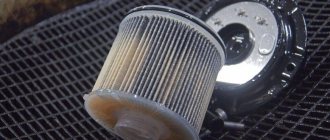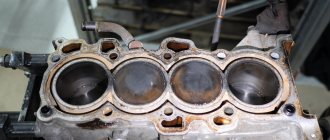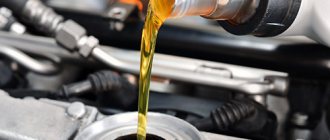Is it necessary to warm up the engine in your car in winter? The question arises with the arrival of cold temperatures. What is interesting about this issue is that opinions are divided into two diametrically opposed ones. Some car enthusiasts will certainly spend time warming up the power plant and only then start driving. And others will not pay the slightest attention to warming up - they will get into the car and start the trip.
So who is right after all? And is it necessary to warm up the car in winter before leaving, and how to do it correctly on different types of engines.
Why warm up the car?
There is such a thing as engine operating temperature. This is the temperature range at which the machine motor operates with maximum efficiency for a certain period of time. For installations running on gasoline, this optimal indicator is the range of 90-100 degrees (in some engines the temperature can reach 110 degrees). For diesel engines, the best option would be a temperature range of 85-90 degrees.
If the temperature drops below these indicators, additional wear of units and components occurs. And also the efficiency decreases, since the liquids servicing the systems do not function efficiently.
This is especially true for engine oil. Which has the necessary properties to service the motor precisely at optimal temperatures. When the car starts cold, the oil will need additional time. To take the desired consistency and begin to lubricate all components of the unit well.
With the oil frozen from low temperatures, the layer enveloping the parts will disappear. And the car will be forced to start with a dry start, which will greatly increase the degree of wear of the mechanisms. The correct choice of oil is also very important here - with thicker oil it will be more difficult for the engine to start working.
Similar problems will arise when starting up a heater that operates using coolant. Additionally, in this case, the engine can turn on speed to warm up, which increases gasoline consumption. Therefore, it becomes obvious whether it is necessary to warm up the car engine in winter.
How long do you need to drive with a cold engine to be able to press the gas pedal to the floor?
We recently wrote about how difficult it is to bring a modern engine to optimal operating temperature. In our previous article, as an example, we gave you the results of the Volkswagen Golf test, which showed how long it takes for the engine to warm up even in slight frost. But there is another side to this complex issue, because it is not as bad as it might seem.
Let us remind you that the optimal engine temperature is not an indicator of the coolant temperature. More important, of course, is the temperature of the engine oil. Unfortunately, the values they show are very different. For example, recent tests have shown that when antifreeze reaches the desired temperature of 90°C, at this time the oil may be at a temperature of about 50°C.
But in practice, none of these indicators tell us exactly what the engine temperature actually is. In addition, many cars do not have an engine oil temperature sensor at all, which makes it difficult for the driver to understand the true warm-up of the engine.
We know that the optimal engine temperature for efficient operation is 80-90⁰C. Accordingly, if the engine oil temperature sensor shows a temperature of about 80-85⁰C, it can be assumed that the engine temperature has reached the optimal value. But there is one interesting point here. Usually the oil sensor is located in the coldest place, that is, in the oil pan.
“The actual engine oil temperature is usually higher than what the sensor shows when displaying information on the dashboard,” Andrey Mazurov, manager of the technical department of Motor Service, rightly notes, in response to our article about the problems of warming up modern engines. “However, this does not change the fact that only a well-warmed engine, including warming up the oil, allows you to use the full power of modern engines with a very complex design. It is no coincidence that most cars do not show the driver the oil temperature and almost all, however, show the antifreeze temperature.
And a coolant sensor is needed in a car not only because engine overheating leads to a very serious failure. If the coolant temperature has reached 90°C, it can be assumed that the engine is ready to operate at full performance range , but even if the oil temperature does not reach the recommended 90°C, it will still protect the engine in critical areas. Moreover, using a not fully warmed-up engine in a reasonable way will also increase the oil temperature faster.
The expert adds that modern engines are well prepared to operate in cold conditions because car manufacturers allow this. It is worth noting that modern engine designs are adapted to Euro 5 and Euro 6 standards, including through the use of motor oils of the appropriate class with low viscosity. This oil provides better protection at low temperatures by protecting moving parts with a film of oil, while at higher temperatures oil additives come into play. That is why it is very important to use exactly the same oil in viscosity and composition as recommended by automakers for their vehicles.
Andrey Mazurov emphasizes that modern turbocharged engines do not require the engine to be revved at high speeds to achieve good acceleration, because maximum torque is often available even below 2000 rpm. So what is the real threat to a “cold” engine?
– A real threat to the durability of a constantly cool engine used in traffic jams does not arise as a result of a one-time high gas pressure. Premature engine wear when constantly operating a car on a cold or underheated engine occurs over a long period of time. And first of all, this happens due to the degradation of the oil in this engine,” explains the expert. – If the engine has not reached a temperature of 85-100⁰C, the oil quickly loses its protective properties primarily due to the fuel, which burns optimally only on a warm engine.
And the more fuel is supplied to a cold engine, the faster the engine oil will lose its protective properties. This is why driving in the city with a cold engine is more harmful than driving at highway speeds, where fuel consumption tends to drop. Therefore, traveling 10-20 kilometers in the city in a cold car is more harmful than driving the same mileage on the highway.
Here we come to the same conclusion that was made in our previous article. Frequent daily trips over short distances in the city do not allow the engine oil to warm up well, which can have negative consequences. By the way, an expert from Motor Service also emphasizes that city driving poses a much greater danger. Of course, urban traffic is different in all localities in Russia.
Somewhere traffic jams rarely form, while in Moscow it is impossible to imagine roads without traffic jams. It also all depends on the number of traffic lights. It is logical that in a city without traffic jams and without a large number of traffic lights, trips on a cold engine are less harmful than the same trips in the morning in Moscow, where a trip to work, as a rule, results in being pushed around in a traffic jam.
To warm up or not
The main rule, according to experienced car owners, is to wait until the engine speed drops to idle, after which you can begin a soft start. At the same time, you need to make sure that the revolutions do not go up: for diesel engines this figure is no more than 1500, for gasoline engines – no more than 2000 revolutions.
If your car is started in severe frosts (minus 20-30 degrees Celsius). The engine will still have to be slightly warmed up until the coolant temperature increases (50-60 degrees).
Warming up for too long will not be of much use - if there is no movement, you can only warm up the engine. And not in the most optimal way. The remaining components of the car (gearbox, axles, gearbox, dampers, as well as gaskets, tires, etc.) will still not be warmed up. It is possible to warm up these units only during soft driving at low speed, so wear on the units will be minimal.
These rules are suitable primarily for gasoline engines, since in severe frosts it is almost impossible to warm up a diesel engine. Autonomous heaters are designed for this, which operate from an additional energy source, such as a battery, mains, etc. The best option for warming up a diesel engine is to drive the car at low speed.
How to properly warm up a car in winter
There are several common options for warming up the engine. In order to determine the difference in atmospheric emissions, experts carried out an experimental test. The initial data for this test were identical for all options: the same car was used as a basis, the same temperature indicators - minus 15 degrees Celsius, a fully charged battery, premium synthetic oil and 5 km of range from the parking lot.
Warm-up options for the experiment:
- Completely warm up the engine at the parking spot (about 20 minutes). After the start, gasoline consumption became 2.5 l/h; after 10 minutes, this figure dropped to 0.9 l/h. The coolant temperature after warming up was less than 50 C. When starting to drive, gasoline consumption was 6.5 l/100 km. A total of 0.73 liters was consumed: 0.4 for warming up and 0.33 liters for the ride itself.
- Warming up when the car is moving. When the engine was started, the car immediately drove: consumption jumped to 10 liters, then dropped to 6.8 liters. A total of 0.45 liters was spent and the warm-up time without moving was saved, as in the first option (about 20 minutes).
- Minimum warm-up in the parking lot before driving for 5 minutes. At the initial stages, the consumption was 7.6 l/100 km, by the end of the ride it was 0.55 l. But this indicator turned out to be higher than in the second option.
However, if we talk about emissions, the third option turned out to be the most effective, where the emission level was no higher than 2.1, and then slightly exceeded 1 gram CH, which meets European standards. In the first option, this level was 180 ppm, and in the second warm-up option – 20 ppm. Therefore, experts recommend minimal warming up when moving further.
What will provide the best engine protection?
“If you only use your car on the home-work-home route, make sure you use the highest quality oil in accordance with the car manufacturer’s instructions, and make sure it is changed in a timely manner,” recommends Armen Harutyunyan, director of the auto service center. – Many engine manufacturers consider urban vehicle use to be heavy-duty operation and recommend shortening oil change intervals by about 1/3 of a kilometer and by about 1/2 in time.
Car owners who change their engine oil following the recommendations of the on-board computer see how oil change intervals change depending on the operating conditions of the car. An example is the multiple examples on the web where people share the oil change intervals of their modern cars.
So, for many cars today, the engine oil, in principle, may not need to be changed every 15,000 or even 20,000 km. But this is in theory and in the plans of automakers. In practice, on-board computers send car owners for maintenance every 10,000-12,000 km. Especially if the car drives through city traffic jams every day. But if your car really suffers every day in traffic jams in the cold, then ideally change the oil every 8,000-10,000 km.
How long should you warm up your car in winter?
How much and how to warm up your car in winter depends on weather conditions:
| Air temperature from | How long to warm up the car | Details |
| 0 to +5 C | 2 minutes | this is the simplest type of warming up |
| from 0 to -10 C | 2-3 minutes | This is the time needed to warm up the car's liquids. |
| from -10 to -20 C | 3-5 minutes | After warming up the engine, take a couple of minutes to warm up the heater |
| from -20 C and below | more than 5 minutes | it takes an additional 10 minutes to heat up the interior |
When warming up the car, pay attention to the coolant temperature readings. Despite the fact that the maximum effective temperature for engine operation is 85-90 C, you can start driving from above 50 C. Driving should be smooth until the optimal temperature of 90 C is reached.
Separately, when warming up, you need to think about a diesel engine, if you are the owner of such a car. Diesel fuel tends to be even more viscous at sub-zero temperatures than other fuels. It will also need to be warmed up along with the engine oil. Therefore, at least minimal warming up is strongly recommended for diesel engines.
It's better to go than to stand
For some reason, many motorists claim that automakers allow the engine not to warm up. This is fundamentally wrong. They require warming up the engine, but not while parked, but while driving at low loads and at relatively low speeds, without sudden acceleration in the first minutes of the trip. This is necessary because during a trip the engine reaches operating temperatures faster. In addition, it emits less harmful substances.
Don't get cocky. How to properly start a car engine after idle time? More details
Thanks to environmental protection programs for the government of many countries, Euro 5 and Euro 6 standards are being introduced, and cars are becoming less harmful to humans. However, when idling after a cold start, increased emissions of harmful substances are still observed. If you stand under the windows of the house and wait until the power unit reaches operating temperature, then neighbors on the first floors may begin to complain about the unpleasant smell of exhaust gases. Therefore, manufacturers instruct not to stand, but to hit the road and warm up the car while driving.
What happens inside the engine if it runs “cold”
The main drawback when operating a cold engine is the increased thickening of all working liquids, from oil to diesel fuel and other similar liquids. If you filled in oil for the summer period, the problem will become more complicated. Since it is in a solid state, it will not allow the starter to rotate the crankshaft. And if you use oil suitable for winter, then the engine will still have to work “cold” until the oil warms up.
After a cold start, the car will increase speed and some of the gasoline will not burn. It will flow through the mechanisms and partially mix with the oil. Thus, a certain layer of oil will be washed off from the parts, which will increase the wear of the structure.
The mixture of fuel and oil can cause carbon deposits on the valves, which reduces their service life. It also affects the power characteristics of the car.
Therefore, when starting in cold weather, you need to take these features into account and control the warm-up time.
Expert opinion
Mechanics who service domestic cars insist on preheating cars all year round to preserve the engine and reduce wear. The lower the air temperature, the higher the viscosity of liquids and mixtures; at subzero temperatures, the oil freezes, so the car needs to be warmed up in winter . Even in extreme heat (for Russia this is above 30 degrees), the oil cannot maintain operating temperature for a long time.
Arguments in favor of warming up:
- Warming up helps lubricate parts and reduce friction while driving, making the wear of the car engine less harmful.
- If the oil is not sufficiently warmed up before driving, the filters will not clean it of harmful elements, chips and various particles, and uncleaned oil will greatly wear out the engine.
- Driving a cold car can damage the pistons and cylinders; the rings on the pistons relieve the engine of excess oil and create pressure. If the car is warmed up, the parts are thoroughly lubricated, and the mechanisms require less time to operate at higher speeds.
Can't start in sub-zero temperatures
| Possible reasons | Solution options |
| Fuel is frozen: the car contains fuel for the summer season; water getting into the fuel; freezing of condensate; clogging of the fuel filter or pipes. | Transporting the car to a warm place, completely changing the fuel and cleaning the fuel unit. |
| Thickening of engine oil. | Taking the car to a warm place, changing the oil with the addition of appropriate additives intended for cold starts. |
| Problems with glow plugs. | Slow warming up of spark plugs or changing them completely. |
| Slow cranking of the crankshaft by the starter. | Disconnecting the battery and then recharging it or replacing it with a new one. |
| The exhaust pipe is clogged with snow or ice. | Pipeline cleaning. |
Warming up for a carburetor engine
If the car is equipped with such an engine, it will be problematic to start moving without warming up. When the air damper is closed, the speed will increase and the fuel mixture will be supplied in a richer form. But in this case, the motor will function intermittently. Such motors always require good heating until stable operation occurs.
The time range that can take to warm up a carburetor internal combustion engine is usually calculated within 10 minutes. Therefore, you should not save time at the risk of the car, but spend it on a good warm-up.
Without this procedure, you may create an emergency situation. Because if the engine stalls on the road, the brake booster will also stop working. There will be no vacuum inside the cylinders and pressing the brake pedal will be problematic, and this is a very unpleasant situation for every driver.
On the topic: is it necessary to warm up a cold engine in winter and how to do it?
- Mineral – at -20…25 °C.
- Synthetic – at 45…45 °C.
As a result, the friction units operate “dry”, the level of mechanical losses increases, and this certainly requires additional fuel costs. However, when will warming up a cooled car engine in winter reach the optimal temperature? If you start the engine and immediately start moving or warm it up in place? Let's test three heating algorithms:
- The classic one is to warm up the engine and then drive.
- Modern - started it up and went.
- Mixed - start, let the internal combustion engine run for 3-5 minutes, and heat it to operating temperature while driving.
For research, a new foreign car from Europe with a 1.6 liter Euro-4 engine was taken.
Classic version
After starting, the tachometer shows 1,200 revolutions, while the fuel consumption is 2.5 l/h. After 60 seconds, consumption dropped to 1.9 liters, and after 10 minutes - to 0.85 liters. The antifreeze temperature reached only 50 °C.
After another 10 minutes, the flow rate dropped to 0.8 l/h, and the coolant temperature remained at 55 °C. We start driving in a fixed mode, reaching 50 km/h, fuel consumption is 6.5 liters per 100 km. As a result, about 0.8 liters of gasoline were spent on heating.
Almost all current car manufacturers recommend starting to drive immediately after starting the internal combustion engine. This is not good for the car, but what automaker looks beyond the warranty period. So, for starters, fuel consumption is 10 liters. After 40-50 seconds it dropped and stopped at 6.7 liters.
As a result, about 0.5 liters of fuel were consumed, plus 20 minutes of personal time were saved. Optimization is obvious, but how justified it is over the long term is a question.
Mixed option
After starting, the engine ran for 5 minutes while the glass was cleared of ice. The movement began at a flow rate of 1.4 l/h at idle. At the start of the run the figure was 7.5 liters per 100 km, and at the end – 6.5. As a result, 0.6 liters were consumed, which is better than the first option, but slightly worse than the second.
Warming up for an injection engine
With the development of the automotive industry, consumers received more technologically advanced engines. Which are equipped with an electronic unit that selects the quality of the fuel mixture. This allows the engine to adjust to the temperature conditions and achieve optimal warm-up as quickly as possible.
Also, modern oils are well adapted to winter temperatures and have the right consistency for “cold starts”.
However, owners of injection engines are recommended to warm the engine as little as possible in any case. If you do not have the required amount of time - 5 or more minutes, such warming up should be reduced to a minimum of one minute. After which you can begin smooth movement without exceeding revolutions above 2200 per minute.
Warming up the car is additionally useful in terms of melting the windshield and organizing a good view for the trip.
Why warm it up and to what temperature?
The question of whether it is necessary to warm up the engine is very controversial. For example, in European countries you can be fined for such a procedure, because there they attach great importance to the environment. And quite a few people here claim that this operation will have a bad effect on the condition of the engine. There is some truth in their opinion. In order for the engine to warm up to normal temperature at idle, you need to wait quite a long time, and such conditions have a bad effect on its operation. When warming up quickly, there is a high probability of failure of the cylinder head or jamming of the pistons. Excessive tension will be to blame in this case.
Warming up the engine
However, if you do not warm up the power unit, then the depreciation of parts associated with the difference in the size of spare parts of a cold engine will increase significantly. Plus insufficient lubrication. All this has an extremely bad effect on the general condition of the engine and can lead to dire consequences.
Depreciation of parts
So how do we resolve these differences? The answer is simple, you just need to follow the manufacturer's recommendations. It is very important to know to what temperature engines warm up. For example, domestic cars can be operated after the engine has warmed up to at least 45 °C. True, the optimal temperature, as well as the warm-up time, depend on the type of engine, time of year, weather, etc. Therefore, you should approach the situation individually.
Warming up for cars with automatic transmission
In addition to warming up the engine, it is very important for these vehicles to warm up the transmission and chassis area. When the engine warms up, the oil does not warm up completely, but reaches the required temperature only after traveling a distance of about 30 km. If there is a torque converter in the gearbox mechanism, this problem becomes especially acute.
Therefore, be sure to warm up your machine. To do this, place your foot on the brake pedal and move the lever to position D. The waiting time for this procedure is approximately 4-5 minutes. Do not start driving your car until you have completed the specified engine warm-up algorithm for the automatic transmission.
Find out the meaning of letters and numbers on the automatic transmission box.
Is it necessary to warm up the car in winter - conclusions
In some countries, there are laws prohibiting long periods of stopping while the engine is running to avoid high emissions into the atmosphere. Therefore, you need to be very careful with such heating, especially in large residential complexes.
However, if you live in a harsh climate zone, warming up may simply become a daily necessity for you. As standard, the rules limit the time of such parking to five minutes - for many cars this time will be more than enough.
Installing additional equipment can make the warm-up procedure easier. Such mechanisms will be useful for gasoline and diesel engines; manufacturers offer a large selection of such products. Therefore, each car owner chooses heating options for himself.










